Introduction to Geological Processes
Introduction to Geological Processes - Earth Structure, Materials, Systems and Cycles
adapted to HTML from lecture notes of Prof. Stephen A. Nelson Tulane UniversityHazardous Processes
The Earth in the
Solar System
The Planet Earth
Minerals
Formation of Minerals
Important Minerals
Rocks
Igneous Rocks
Sedimentary Rocks
Metamorphic Rocks
Geological Processes
Energy
Forms of Energy
Sources of Energy
Heat Transfer
Time Scales
Plate Tectonics
Divergent Boundaries
Convergent Boundaries
Transform Fault Boundaries
Why Does Plate
Tectonics Occur?
Geologic Cycles
Hydrologic Cycle
Biochemical Cycles
Rock Cycle
Uniformitarianism and
Catastrophism
Hazardous Processes
Geology is the study of the Earth and its history.
Geologic Processes effect every human on the Earth all of the time, but are most noticeable when they cause loss of life or property. Such life or property threatening processes are called natural disasters. Among them are:
- Earthquakes
- Eruptions of Volcanoes
- Tsunamis
- Landslides
- Subsidence
- Floods
- Droughts
- Hurricanes
- Tornadoes
- Meteorite Impacts
All of these processes have existed throughout Earth history, but the processes have become hazardous only because they negatively affect us as human beings. Important Point - There would be no natural disasters if it were not for humans. Without humans these are only natural events.
Risk is characteristic of the relationship between humans and geologic processes. We all take risks everyday. The risk from natural disasters, while it cannot be eliminated, can, in some cases be understood in a such a way that we can minimize the hazard to humans, and thus minimize the risk. To do this, we need to understand something about the processes that operate, and understand the energy required for the process. Then, we can develop an action to take to minimize the risk. Such minimization of risk is called hazard mitigation.
Although humans can sometimes influence natural disasters (for example when road construction sets off a landslide), other disasters that are directly generated by humans, such as oil and toxic material spills, pollution, massive automobile or train wrecks, airplane crashes, and human induced explosions, are considered technological disasters, and will not be considered in this course.
Some of the questions we hope to answer for each possible natural disaster are:
- Where is each type of disaster likely to occur and why?
- How often do these disasters occur?
- How can each type of disaster be predicted and/or mitigated?
The Earth in the Solar System
The Solar System
- The Earth is one of nine planets in the solar system
- In addition to the planets, many smaller bodies called asteroids, comets, meteoroids are present.
- All objects in the solar system orbit around the Sun.
- The four planets closest to the Sun (Mercury, Venus, Earth, and Mars) have high densities because they are mostly composed of rock, and are called the Terrestrial Planets.
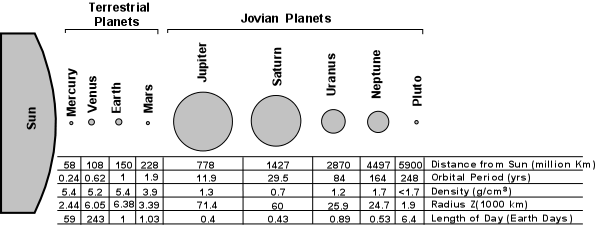
Origin of the Solar System
- Original Solar Nebula
- Condensation of the Sun about 6 billion years ago
- Condensation of the Planets about 4.5 billion years ago.
- Process is continuing today, although at a much slower rate.
The Planet Earth
The Planet Earth
Comparisons Between Earth and the Other Planets
- Earth similar in size density and structure to the terrestrial planets (all have metallic core, high density, composed of rock, with thin to non-existent atmosphere.
- Earth is the only planet with an atmosphere composed of Nitrogen, Oxygen, Carbon Dioxide, and Water Vapor.
- Earth is the only planet that has a hydrosphere, a region on the surface where water can exist in liquid, vapor and solid forms. This is due to the Temperature on the Earth's surface that usually remains between the freezing point of water, 0oC, and the boiling point of water, 100oC. Temperature on the Earth is controlled by the distance from the Sun and by the atmosphere of the Earth, which tends to moderate temperature variation.
- Earth is the only planet with a biosphere, (life sphere) which is made up of all living matter. The biosphere exists because of the Earth's temperature, and because of the atmosphere. Oxygen is present in the atmosphere because of the biosphere.
- Earth is the only planet with a regolith. Regolith is a thin covering of loose rock debris that has formed as a result of a process called weathering. Weathering is the mechanical and chemical response of interactions between the rocks of the Earth and its hydrosphere, atmosphere, and biosphere. While other planets have something resembling regolith, most formed as a result of meteorite impacts which have mechanically broken the surface into loose fragments of rock. The Earth is unique in that other processes have occurred to produce a more varied regolith.
- The Earth has a radius of about 6371 km, although it is about 22 km larger at equator than at poles.
- Density, (mass/volume), Temperature, and Pressure increase with depth in the Earth.
- The Earth has a layered structure. This layering can be viewed in two different ways (1) Layers of different chemical composition and (2) Layers of differing physical properties.
- Compositional Layering
- Crust - variable thickness and composition
- Continental 10 - 70 km thick
- Oceanic 8 - 10 km thick
- Mantle - 3488 km thick, made up of a rock called peridotite.
- Core - 2883 km radius, made up of Iron (Fe) and small amount of Nickel (Ni)
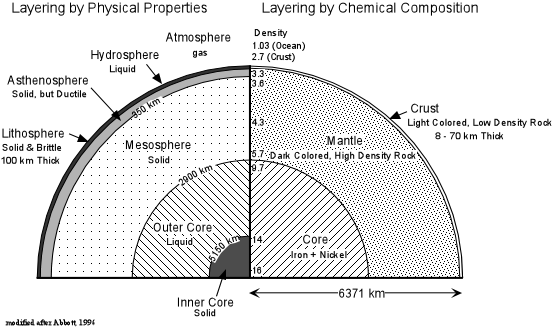
- Layers of Differing Physical Properties
- Lithosphere - about 100 km thick (up to 200 km thick beneath continents), very brittle, easily fractures at low temperature.
- Asthenosphere - about 250 km thick - solid rock, but soft and flows easily (ductile).
- Mesosphere - about 2500 km thick, solid rock, but still capable of flowing.
- Outer Core - 2250 km thick, Fe and Ni, liquid
- Inner core - 1230 km radius, Fe and Ni, solid
Minerals
Before we can begin to understand the causes and effects of natural disasters we need to have some understanding of the materials that make up the Earth, the processes that act on these materials, and the energy that controls the processes. We start with the basic building blocks of rocks - Minerals.
The Earth is composed of rocks. Rocks are aggregates of minerals. Minerals are composed of atoms. In order to understand rocks, we must first have an understanding of minerals. We'll start with the definition of a Mineral. A Mineral is
Naturally formed (it forms in nature on its own [some say without the aid of humans]) Solid ( it cannot be a liquid or a gas)
With a definite chemical composition (every time we see the same mineral it has the same chemical composition that can be expressed by a chemical formula).
and a characteristic crystalline structure (atoms are arranged within the mineral in a specific ordered manner).
Examples Glass - can be naturally formed (volcanic glass called obsidian), is a solid, its chemical composition, however, is not always the same, and it does not have a crystalline structure (individual atoms in a glass are arranged randomly similar to the arrangement in a liquid). Thus, glass is not a mineral. Ice - Is naturally formed, is solid, does have a definite chemical composition that can be expressed by the formula H2O, and does have a definite crystalline structure when solid. Thus, ice is a mineral. Liquid water is not since it is not solid and does not have a crystalline structure.
Halite (salt) - Is naturally formed, is solid, does have a definite chemical composition that can be expressed by the formula NaCl, and does have a definite crystalline structure, as shown below. Thus halite is a mineral.
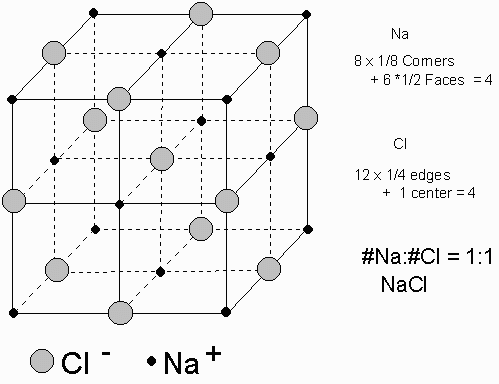
Important Minerals in the Earth's Crust The variety of minerals we see depend on the chemical elements available to form them. In the Earth's crust the most abundant elements are as follows:
- O, Oxygen 45.2% by weight
- Si, Silicon 27.2%
- Al, Aluminum 8.0%
- Fe, Iron 5.8%
- Ca, Calcium 5.1%
- Mg, Magnesium 2.8%
- Na, Sodium 2.3%
- K, Potassium 1.7%
- Ti ,Titanium 0.9%
- H, Hydrogen 0.14%
- Mn, Manganese 0.1%
- P, Phosphorous 0.1%
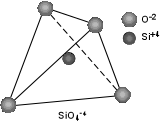
fig.1 Silicate tetrahedron
Because of the limited number of elements present in the Earth's crust there are only about 3000 minerals known. Only 20 to 30 of these minerals are common. The most common minerals are those based on Si and O: the Silicates. Silicates are based on SiO4 tetrahedron. 4 Oxygens bonded to one silicon atom(fig1)
Formation of Minerals
Minerals are formed in nature by a variety of processes. Among them are:
- Crystallization from melt - the process that results in igneous rocks.
- Precipitation of water - the process that results in chemical sedimentary rocks.
- Precipitation from living organisms - the process that results in biochemical sedimentary rocks
- Change to more stable state - the process that results in the formation of soil, through weathering, and the formation of metamorphic rocks.
- Precipitation from vapor. (not common, but sometimes does occur around volcanic vents)
Since each process leads to different minerals, we can identify the process by which minerals form in nature. Each process has specific Temperature and pressure conditions that can be determined from laboratory experiments.
Important Minerals
For the purposes of this course, three minerals that are most important (others may be introduced as needed) are:
Quartz - Chemical Formula SiO2. - Quartz is one of the primary minerals that originally forms by crystallization from a melt in igneous rocks. Although quartz is formed at relatively high temperatures it is stable (does not break down or alter) at conditions present near the Earth's surface. Thus quartz is a primary constituent of sand, soil, and sedimentary rocks called sandstones.
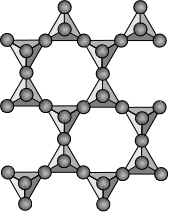 fig 2.
fig 2.Clay Minerals - Clay minerals are sheet silicates, thus they have a crystalline structure that allows them to break easily along parallel sheets. Clay minerals form by alteration of other minerals during the process of chemical weathering (alteration under conditions present near the Earth's surface). Thus clay minerals are primary constituents of soils and are also found in the sedimentary rock known as shale or mudstone.(fig.2)
fig.2 Sheet Silicates
Calcite - chemical formula CaCO3 (calcium carbonate). Calcite is easily dissolved in water under slightly acidic conditions. Thus calcite can be precipitated directly from water. Organisms can extract the Calcium and Carbonate ions from water to precipitate their shells. Thus calcite is a primary constituent of chemical and biochemical sedimentary rocks.
Rocks
Rocks are aggregates of minerals that are held together to form a consolidated mass.The three general types of rocks are:
Igneous Rocks
Igneous Rocks - rocks that result from crystallization from a melt - called a magma.If the crystallization takes place deep beneath the surface of the Earth they are called Plutonic rocks.
Examples include:
Granite - coarse textured rock consisting mostly of quartz, and feldspar with small amounts of biotite and/or hornblende.
Gabbro - a coarse textured rock consisting mostly of pyroxenes, and plagioclase.
If the crystallization takes place on the surface of the Earth they are called Volcanic rocks.
Examples include:
Rhyolite - a fine grained to glassy rock containing crystals of quartz, feldspar, and biotite - chemically the same as a granite.
Andesite - a fined grained rock containing crystals of pyroxene, plagioclase, and sometimes hornblende.
Basalt - a fine grained rock containing crystals of olivine, pyroxene, and plagioclase - chemically the same as a gabbro.
Sedimentary Rocks
Sedimentary Rocks - rocks that form near the surface of the Earth through chemical precipitation from water or by cementation of loose fragments (called sediment).
Clastic Sedimentary Rocks - result from the cementation of loose fragments of pre-existing rock. The cementation occurs as a result of new minerals precipitating in the space between grains. Clastic sedimentary rocks are classified on the basis of the size of the fragments that makes up the rock
| Name of Particle | Size Range | Loose Sediment | Consolidated Rock |
|---|---|---|---|
| Boulder | >256 mm | Gravel | Conglomerate (if clasts are rounded) or Breccia (if clasts are angular) |
| Cobble | 64 - 256 mm | Gravel | |
| Pebble | 2 - 64 mm | Gravel | |
| Sand | 1/16 - 2mm | Sand | Sandstone |
| Silt | 1/256 - 1/16 mm | Silt | Siltstone |
| Clay | <1/256 mm | Clay | Claystone, mudstone, and shale |
Chemical Sedimentary Rocks - result from direct chemical precipitation from surface waters. This usually occurs as a result of evaporation which concentrates ions dissolved in the water and results in the precipitation of minerals.
Biochemical Sedimentary Rocks - result from the chemical precipitation by living organisms. The most common biochemical sedimentary rock is limestone, which is composed of the shells of organisms, which are in turn composed mostly of the mineral calcite.
Metamorphic Rocks
Metamorphic Rocks - result when any kind of pre-existing rock is buried deep in the Earth and subjected to high temperatures and pressures. Most metamorphic rocks show a texture that shows an alignment of sheet silicate minerals, minerals like biotite and muscovite, that gives them a layered appearance and allows them to break easily along nearly planar surfaces. Some common metamorphic rocks that we might encounter in this course are:
Slate - a fine grained metamorphic rock consisting mostly of clay minerals that breaks easily along smooth planar surfaces.
Schist - a coarser grained metamorphic rock consisting of quartz and micas that breaks along irregular wavy surfaces.
Geologic Processes
A variety of processes act on and within the Earth - here we consider those responsible for Natural Disasters
Energy
All processes that occur on or within the Earth require energy. Energy can exist in many different forms, and comes from a variety of sources. Natural disasters occur when there is a sudden release of the energy near the surface of the Earth.Forms of Energy
Forms of EnergyEnergy may exist in many different forms, but can be converted between each of these forms
Sources of Energy
The Earth has two basic sources of energy - that reaching the Earth from the Sun (Solar Energy) and that reaching the surface of the Earth the Earth itself (Internal or Geothermal Energy).Solar Energy - reaches the Earth in the form of radiant energy, and makes up 99.987% of the energy received by the Earth.
About 40% is immediately reflected back into space by the atmosphere and oceans.
Some is converted to heat and is absorbed by the atmosphere, hydrosphere, and lithosphere, but even this eventually escapes into space.
Some is absorbed by plants during photosynthesis and is stored in plants, used by other organisms, or is stored in fossil fuels like coal and petroleum.
Solar Energy drives the water cycle, causing evaporation of the oceans and circulation of the atmosphere, which allows rain to fall on the land and run downhill. Thus solar energy is responsible for such natural disasters as severe weather, and floods.
Internal Energy - is generated within or because of the Earth. It only amounts to about 0.013% of the total energy reaching the Earth's surface, but is responsible for deformational events that build mountains and cause earthquakes, for melting in the Earth to create magmas that result in volcanism.
Two source of internal energy are:
Radioactive Decay
- Some elements like Uranium, Thorium, and Potassium have unstable isotopes that we say are radioactive.
- When a radioactive isotope decays to a more stable isotope, subatomic particles like protons, neutrons, and electrons are expelled from the radioactive parent atom and are slowed and absorbed by surrounding matter.
- The energy of motion (kinetic energy) of these particles is converted to heat by the collision of these particles with the surrounding matter.
- Although radioactive isotopes like 235U (Uranium), 232U, 232Th (Thorium), and 40K (potassium) are not very abundant in the Earth, They are sufficiently plentiful that large amounts of heat are generated in the Earth.
- Gravity is the force of attraction between two bodies.
- The force of gravity acts between the Sun, Earth, and Moon to create tidal forces, which cause the Earth to bulge in the direction of the Moon. This bulging is kinetic energy, which is converted to heat in the Earth.
- Gravity has other energy effects near the surface of the Earth. All objects at the Earth's surface are continually being pulled toward the center of the Earth by the force of gravity.
- When an object moves closer to the center of the Earth by falling, slipping, sliding, or sinking, kinetic energy is released.
Some of the heat flowing out of the Earth is heat that has been produced by gravitational compaction of the Earth which has caused matter to move closer to Earth's center.
Heat Transfer
Heat TransferSince much of the energy that reaches the Earth's surface eventually is converted to heat, it is important to understand how heat can move through materials. Three basic modes of heat transfer are possible
- Conduction - atoms vibrate against each other and these vibrations move from high temperature areas (rapid vibrations) to low temperature areas (slower vibrations).- Heat from Earth's interior moves through the solid crust by this mode of heat transfer.
- Convection - Heat moves with the material, thus the material must be able to move. The mantle of the Earth appears to transfer heat by this method, and heat is transferred in the atmosphere by this mode (causing atmospheric circulation).
- Radiation - Heat moves with electromagnetic radiation (light) Heat from the Sun is transferred by this mode, and thus radiative heat transfer is responsible for warming the oceans and atmosphere, and for re-radiating heat back into space
Time Scales
As discussed before, the Solar System began to form about 6 billion years ago and the Earth and other planets about 4.5 billion years ago. Geologic processes have operated on the Earth ever since. Some of these processes, like mountain building events expend energy on time scales of several hundred million years, whereas others, like earthquakes, expend energy on time scales of a few seconds (although the storage of energy for such an event may take hundreds or thousands of years). If we examine the time scales of various geologic and other processes, we see that those processes that affect humans and that may be responsible for natural disasters occur on time scales less than a few years.
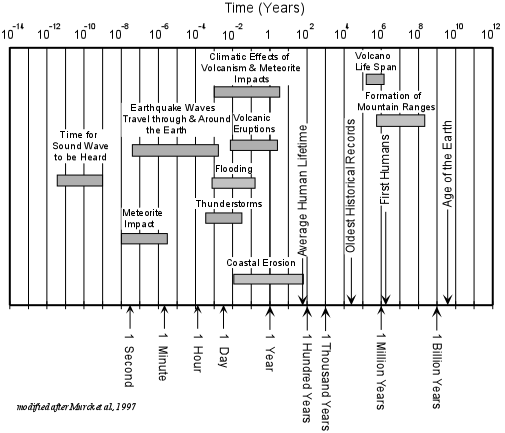
Plate Tectonics
Much of what occurs near the surface of the Earth is due to interactions of the lithosphere with the underlying asthenosphere. Most of these interactions are caused by plate tectonics. Plate Tectonics is a theory developed in the late 1960s, to explain how the outer layers of the Earth move and deform. The theory has caused a revolution in the way we think about the Earth. Since the development of the plate tectonics theory, geologists have had to reexamine almost every aspect of Geology. Plate tectonics has proven to be so useful that it can predict geologic events and explain almost all aspects of what we see on the Earth.The theory states that the Earth's lithosphere is divided into plates (about 100 km thick) that move around on top of the asthenosphere. Continental crust is embedded within the lithospheric plates. The Plates move in different directions, and meet each other at plate boundaries.
The plates and their boundaries are shown below:

Plate boundaries are important because plates interact at the boundaries and these are zones where deformation of the Earth's lithosphere is taking place. Thus, plate boundaries are important areas in understanding geologic hazards. Three types of plate boundaries occur:
Divergent Plate Boundaries

Divergent Plate Boundaries - These are boundaries where plates move away from each other, and where new oceanic crust and lithosphere are created. Magmas rising from the underlying asthenosphere intrude and erupt beneath and at an oceanic ridge to create new seafloor. This pushes the plates on either side away from each other in opposite directions.
The margin itself becomes uplifted to form oceanic ridges, which are also called spreading centers, because oceanic lithosphere spreads away on each side of the boundary. While most diverging plate boundaries occur at the oceanic ridges, sometimes continents are split apart along zones called rift zones, where new oceanic lithosphere may eventually form. Volcanism and earthquakes are common along diverging plate boundaries
Convergent Plate Boundaries
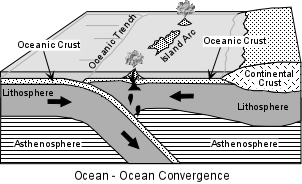
Convergent Plate Boundaries - These are boundaries where two plates move toward each other. Atsuch boundaries one of the plates must sink below the other in a process called subduction. Two types of convergent boundaries are known.
Subduction Boundaries - These occur where either oceanic lithosphere subducts beneath oceanic lithosphere (ocean-ocean convergence), or where oceanic lithosphere subducts beneath continental lithosphere (ocean-continent convergence). Where the two plates meet, an oceanic trench is formed on the seafloor, and this trench marks the plate boundary.
When two plates of oceanic lithosphere run into one another the subducting plate is pushed to depths where it causes melting to occur. These melts (magmas) rise to the surface to produce chains of islands known as island arcs. A good example of an island arc is the Caribbean islands.
When an plate made of oceanic lithosphere runs into a plate with continental lithosphere, the plate with oceanic lithosphere subducts because it has a higher density than continental lithosphere.
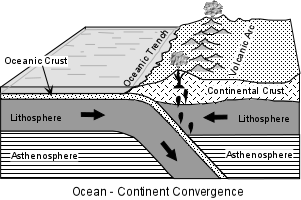
Again, the subducted lithosphere is pushed to depths where magmas are generated, and these magmas rise to the surface to produce, in this case, a volcanic arc, on the continental margin. Good examples of this type of volcanic arc are the Cascade mountains of the northwestern U.S. and the Andes mountains of South America. squeezing together and uplifting the continental crust on both plates. The Himalayan mountains between India and China where formed in this way, as were the Appalachian Mountains about 300 million years ago
All convergent boundaries are zones of frequent and powerful earthquakes.
Transform Fault Boundaries
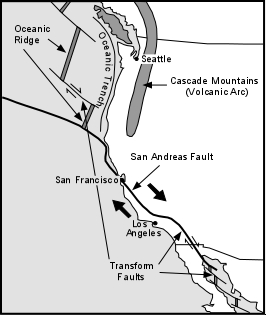
Transform Fault Boundaries- When two plates slide past one another, the type of boundary occurs along a transform fault. These are also zones of frequent and powerful earthquakes, but generally not zones of volcanism. The famous San Andreas Fault of California is an example of a transform fault, forming one part of the boundary between the Pacific Plate and the North American Plate.
Why Does Plate Tectonics Occur?
- Plate tectonics is driven by the internal energy of the Earth. Although there is some debate among geoscientists as to the exact mechanism, most agree that motion of the plates is ultimately driven by convection currents in the mantle.
- Recall that convection is a means of heat transfer wherein the heat moves with the material. It occurs when conduction is inefficient at transporting heat, particularly if the material has a low thermal conductivity, like rocks.
- Recall also that the Earth's asthenosphere is ductile, and therefore is likely to flow more readily than the overlying lithosphere.
Thus, if the asthenosphere moves by convection, with rising currents carrying heat toward the surface at the oceanic ridges, and, descending currents sinking at subduction zones after loosing heat to the surface, then the brittle plates riding on top of the convection cell will be forced to move over the surface, being in a sense, dragged along by the moving asthenosphere.

Geologic Cycles
Although we have discussed various parts of the Earth as separate entities, in reality each of the entities, atmosphere, hydrosphere, lithosphere, etc, interact with each other continuously exchanging both matter and energy. This exchange of matter and energy occurs on a cyclical basis, with both matter and energy cycling between various storage reservoirs on various time scales. Because matter and energy is thus cycled, the various geologic cycles play a large role in the development of natural disasters. We here look at a few of these geologic cycles.
Hydrologic Cycle
Perhaps the easiest of the cycles to understand is the hydrologic cycle that involves the movement of water throughout Earth systems. Water moves between 7 main reservoirs:
- the oceans
- the atmosphere where it moves in the clouds transported by winds
- glaciers and ice sheets
- surface lakes and streams
- groundwater (water that moves in the pore spaces in rock beneath the surface)
- the biosphere, and
- the lithosphere, where it is held within the crystallographic structure of hydrous (water bearing) minerals.
| Reservoir | % | Input | Output | Residence Time |
|---|---|---|---|---|
| Oceans | 97.5 | Precipitation from Atmosphere Melting of Glaciers Flowage from Streams Flowage from Groundwater |
Evaporation into Atmosphere Subduction into Lithosphere |
Thousands of years |
| Atmosphere | <0.01 | Evaporation from Oceans Evaporation from Surface waters Transpiration from Biosphere Volcanism from Lithosphere |
Precipitation as snow and rain on land and in Oceans Uptake by Biosphere |
A few days |
| Glaciers | 1.85 | Precipitation from Atmosphere | Melting into Surface Waters Melting into Oceans Evaporation into Atmosphere |
Thousands of years |
| Surface Lakes & Streams | <0.01 | Precipitation from Atmosphere Melting from Glaciers Flowage from Groundwater |
Seepage into Groundwater Flowage into Oceans Evaporation into Atmosphere |
A few weeks |
| Groundwater | 0.64 | Seepage from Surface Lakes & Streams Seepage from Oceans Precipitation from Atmosphere |
Flowage into Surface Lakes & Streams Flowage into Oceans Uptake by Biosphere |
Hundreds of years |
| Biosphere | <0.01 | Uptake from Surface Waters, Atmosphere, Oceans, and Groundwater | Transpiration into Atmosphere Burial into Lithosphere |
A few days |
| Lithosphere | ? | From Groundwater into Hydrous Minerals From Biosphere by burial into Sediments From Oceans by Subduction |
Weathering into Groundwater & Oceans Volcanism into Atmosphere |
Millions of years |
The main pathway by which water moves is through the atmosphere. Two main sources of energy drive the cycle:
- Solar energy causes evaporation of the surface waters and atmospheric circulation, and gravitational energy causes the water to flow back to oceans. Residence time in each of the reservoirs is generally proportional to the size of the reservoir
- with water residing in the oceans and glaciers for many thousands of years,
- in groundwater for hundreds of years,
- in surface waters for months,
- in the atmosphere and biosphere for days.
Biogeochemical Cycles
Although the hydrologic cycle involves the biosphere, only a small amount of the total water in the system at any given time is in the biosphere. Other materials, for example Carbon and Nitrogen have a much higher proportion of the total residing in the biosphere at any given time. Cycles that involve the interactions between other reservoirs and the biosphere are often considered differently because they involve biological processes like respiration, photosynthesis, and decomposition (decay). These are referred to as biogeochemical cycles.A good example is the Carbon Cycle, as it involves the cycling of Carbon between 4 major reservoirs:
- Biosphere, where it is the major building block of life,
- Lithosphere, where it is a component in carbonate minerals and rocks and fossil fuels such as coal and petroleum,
- Oceans, where it occurs as a dissolved ion in seawater, and
- Atmosphere, where it occurs as Carbon Dioxide (CO2) gas.
| Reservoir | Input | Output |
|---|---|---|
| Biosphere | From Lithosphere by plant uptake From Oceans by chemical precipitation From Atmosphere by photosynthesis |
Into Lithosphere by burial Into Oceans by decay Into Atmosphere by decay, respiration, & burning |
| Lithosphere | From Biosphere by Burial From Oceans by chemical precipitation From Atmosphere by precipitation & groundwater flow |
Into Biosphere by uptake of organisms Into Oceans by dissolution (weathering) |
| Oceans | From Atmosphere by precipitation From Lithosphere by dissolution From Biosphere by decay & respiration |
Into Biosphere by uptake of organisms Into Lithosphere by chemical precipitation Into Atmosphere by evaporation |
| Atmosphere | From Biosphere by respiration, burning, & decay From lithosphere by seepage of and burning fossil fuels and volcanism From the Oceans by evaporation |
Into Biosphere by photosynthesis Into Oceans by precipitation |
In all reservoirs except the lithosphere, residence time is generally short, on the order of a few years. Human burning of fossil fuels adds Carbon back to the atmosphere at a higher rate than normal, and thus the concern for greenhouse gas warming induced by humans.
The Rock Cycle
- The rock cycle involves cycling of elements between various types of rocks, and thus mostly involves the lithosphere.
- But, because materials such as water and Carbon cycle through the lithosphere, the rock cycle overlaps with these other cycles.
- The rock cycle involves the three types of rocks as reservoirs (1) igneous, (2) sedimentary, and (3) metamorphic.
- Chemical elements can reside in each type of rock, and geologic processes move these elements into another type of rock.
- The rock cycle can be divided into two main circuits, one through continental crust, and one through the mantle.
- Energy for the parts of the crustal cycle near the Earth's surface is solar and gravitational energy (which control erosion and weathering), whereas energy that drives processes beneath the surface is geothermal and gravitational energy (which control uplift, subsidence, melting, and metamorphism).
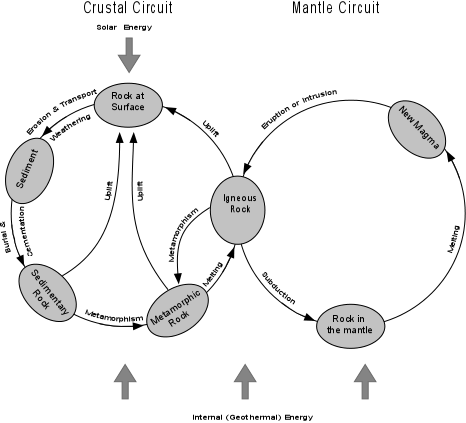
Uniformitarianism and Catastrophism
Prior to about 1850 most humans thought of the Earth as being a relatively young feature and that processes and landforms that occur on the Earth were the result of catastrophic events (like creation and the flood) that occurred very rapidly. But, careful observation of Earth process led some, like James Hutton and Charles Lyell) to hypothesize that processes that one could observe taking place at the present time had operated throughout the history of the planet. This led to the development of the concept of uniformitarianism, often stated as "the present is the key to the past". A more modern way of stating this principle is that since the laws of nature have operated the same way throughout time, and all Earth processes must obey the laws of nature (i.e the laws of physics and chemistry. Initially one of the most difficult problems in applying this principle to the Earth, was that an assumption was made that the rates of all geologic processes had been the same throughout time. We know that the Earth is very old (4.5 billion years) and that it was hotter near its birth than it is now. Thus, it is likely that the rates of some geologic processes has changed throughout time. We also now recognize that there can in fact be catastrophic events that occur infrequently that can cause very rapid changes in the Earth. Because these catastrophic events occur infrequently, it is difficult to observe their effects, but if we can recognize them, we still can see that even these infrequent catastrophic events follow the laws of nature.

